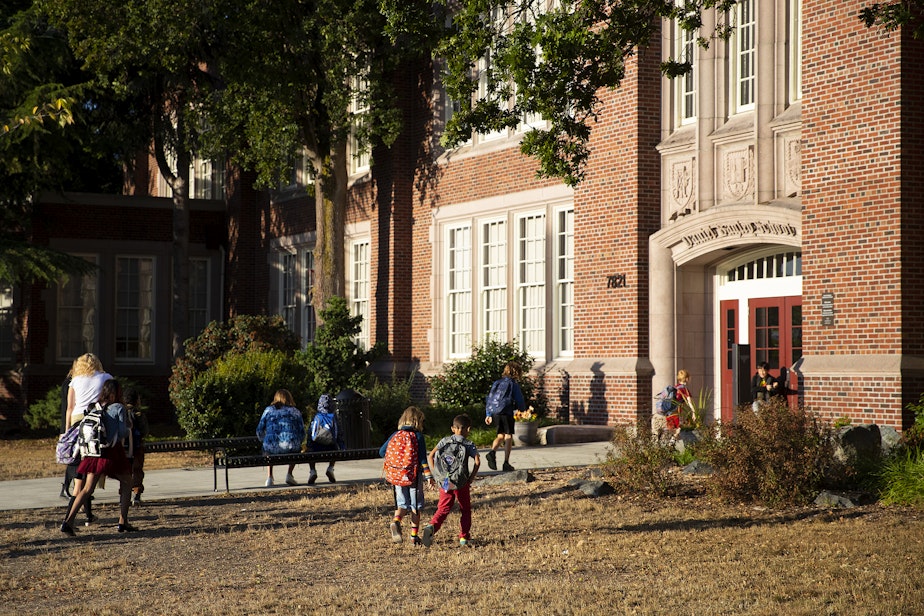Seattle Public Schools enrollment ticks up slightly as district moves ahead with closures

Seattle Public Schools' argument for closing schools largely hinges on a budget crisis fueled by declining enrollment. But this year's enrollment surpassed the district's prediction.
New enrollment data shows that, as of Oct. 1, the district is serving a total of 51,205 students this year. That count includes preschoolers and students who participate full-time in Running Start, a program that allows high school juniors and seniors to take college classes for free. By that measure, it's an increase of just over 200 students from this time last year.
Without preschoolers and Running Start, enrollment is sitting at 49,240 this year — up by just 14 students from the year before.
Either way, the latest enrollment figures show an increase of less than 1% in Washington's largest public school system.
It's the first time enrollment has ticked up in five years, and comes as a surprise after projections from the district and two external demographers forecasted enrollment would continue to decline for at least a decade.
Superintendent Brent Jones acknowledged the uptick, but said it doesn't change closure plans. He said the district's ultimate goal is to increase capacity across all elementary schools from around 65% currently to around 85%, so that resources are distributed more equitably and effectively.
Sponsored
"Although we've seen slight increases, a little more than projected, it's not enough to necessarily say we are at that place where we're maximizing our space," Jones said.
RELATED: 1 in 6 Seattle kids go to private school. Is that a factor in public school struggles?
Seattle Public Schools enrollment has dropped by more than 4,000 students since 2019. District leaders have pointed to this trend — plus chronic underfunding from the state — as two of the largest reasons the district has grappled with massive budget shortfalls the last several years.
Next year, officials say the district faces a $94-million gap, and they propose shuttering four elementary schools to save about $5 million.
In his latest school closure plan unveiled Thursday, Jones recommended North Beach, Sacajawea, Sanislo, and Stevens elementary schools be shuttered.
Sponsored
RELATED: 4 Seattle schools up for closure revealed
All Together for Seattle Schools, a grassroots community activist group, said they're pleased to see enrollment has increased — and it helps their case against school closures.
"The fact that enrollment in Seattle Public Schools surpassed even the most optimistic projections from SPS is yet another example of the district's inability to manage enrollment, and an indicator of the larger mismanagement trend by the district leadership," the group said in a statement. "It also removes a central justification for SPS's effort to close public schools."
The group added: "The fact that enrollment is starting to rise suggests that recent declines may be a temporary side-effect of the pandemic. Rather than close schools, we encourage SPS to ramp up its efforts to recruit families into the district, gather better data, and partner with the community to build a great public school district that meets the needs of every child."
For months, district officials have stressed that they're confident in their enrollment projections, seeking to quell concerns that the district's closure history will repeat itself.
Sponsored
RELATED: Seattle families brace for school closures. What can we learn from last time?
Seattle’s last wave of public school closures occurred in 2007 and 2008. The move was met with parent and community outcry, and it led to lawsuits, security and safety concerns at district events, the attempted recall of some school board members, and the departure of the superintendent. By October 2009, the district was seeing a turnaround in enrollment, and officials had to spend millions of dollars to reopen many of the schools they had just shut down.
At a press conference last week, SPS Well-Resourced Schools Officer Marni Campbell once again defended the projections and closure plans. She said the district still has more buildings than it needs to accommodate the students they serve.
Superintendent Brent Jones also stressed that the closure plans include buffers in case enrollment increases. In a FAQ on the district website, officials say capacity analyses include a minimum 5% cushion "to leave space for unanticipated changes."
Jones also emphasized the district currently has no plans to sell any schools, and they're working to boost enrollment.
Sponsored
"There could be a time in the near future, hopefully, that our enrollment comes back and we'll need those buildings," he said. "But right now, again, we're at 65% capacity for elementary schools. Even if we got to 85%, we'd still have some capacity."
Thanks to a $100,000 grant from the state, the district is conducting a study to look for ways to draw in and retain more students. The findings are due in December.




